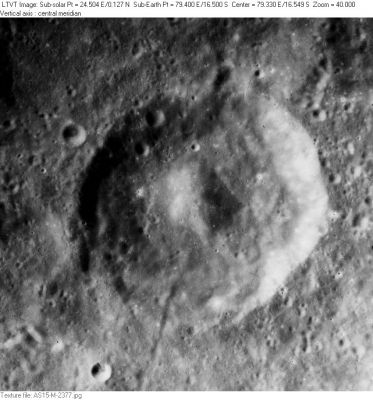Difference between revisions of "Behaim"
(Created page with "<div id="content_view" class="wiki" style="display: block"> =Behaim= {| class="wiki_table" | Lat: 16.5°S, Long: 79.4°E, Diam: 55 km, Depth: 3.33 km, [/R%C3%BCkl%2060 Rü...") |
|||
| Line 3: | Line 3: | ||
{| class="wiki_table" | {| class="wiki_table" | ||
| | | | ||
| − | Lat: 16.5°S, Long: 79.4°E, Diam: 55 km, Depth: 3.33 km, [ | + | Lat: 16.5°S, Long: 79.4°E, Diam: 55 km, Depth: 3.33 km, [[R%C3%BCkl%2060|Rükl: 60]]<br /> |
|} | |} | ||
<div id="toc"> | <div id="toc"> | ||
| Line 11: | Line 11: | ||
[http://www.lpod.org/coppermine/thumbnails.php?album=search&type=full&search=Behaim LPOD Photo Gallery] [http://www.lpi.usra.edu/resources/lunar_orbiter/bin/srch_nam.shtml?Behaim%7C0 Lunar Orbiter Images] [http://www.lpi.usra.edu/resources/apollo/search/feature/?feature=Behaim Apollo Images]<br /> - The crew of Apollo 8 (mankind's first manned spaceflight mission to orbit the moon) made south-looking oblique close up photographs of '''Behaim''' and its pronounced central peak. One of those photographs is [http://history.nasa.gov/ap08fj/photos/13-e/med/as08-13-2269.jpg AS8-13-2269]. In this photograph, nearby '''Ansgarius''' is visible at the lower part of the frame.<br /> Research: Danny Caes<br /> HiRes scan of this photograph: David Woods and Frank O'Brien (Apollo 8 Flight Journal)<br /> <br /> | [http://www.lpod.org/coppermine/thumbnails.php?album=search&type=full&search=Behaim LPOD Photo Gallery] [http://www.lpi.usra.edu/resources/lunar_orbiter/bin/srch_nam.shtml?Behaim%7C0 Lunar Orbiter Images] [http://www.lpi.usra.edu/resources/apollo/search/feature/?feature=Behaim Apollo Images]<br /> - The crew of Apollo 8 (mankind's first manned spaceflight mission to orbit the moon) made south-looking oblique close up photographs of '''Behaim''' and its pronounced central peak. One of those photographs is [http://history.nasa.gov/ap08fj/photos/13-e/med/as08-13-2269.jpg AS8-13-2269]. In this photograph, nearby '''Ansgarius''' is visible at the lower part of the frame.<br /> Research: Danny Caes<br /> HiRes scan of this photograph: David Woods and Frank O'Brien (Apollo 8 Flight Journal)<br /> <br /> | ||
==Maps== | ==Maps== | ||
| − | ''([ | + | ''([[LAC%20zone|LAC zone]] 99A2)'' [http://planetarynames.wr.usgs.gov/images/Lunar/lac_99.pdf USGS Digital Atlas PDF]<br /> <br /> |
==Description== | ==Description== | ||
<br /> | <br /> | ||
==Description: Elger== | ==Description: Elger== | ||
| − | ''([ | + | ''([[IAU%20Directions|IAU Directions]])'' BEHAIM.--A great ring-plain, 65 miles in diameter, S. of [[Ansgarius|Ansgarius]], and connected with it by ridges. It has lofty walls and a central mountain.<br /> <br /> |
==Description: Wikipedia== | ==Description: Wikipedia== | ||
[http://en.wikipedia.org/wiki/Behaim_(crater) Behaim]<br /> <br /> | [http://en.wikipedia.org/wiki/Behaim_(crater) Behaim]<br /> <br /> | ||
==Additional Information== | ==Additional Information== | ||
| − | Depth data from [ | + | Depth data from [[Kurt%20Fisher%20crater%20depths|Kurt Fisher database]]<br /> |
* Westfall, 2000: 3.33 km | * Westfall, 2000: 3.33 km | ||
* Cherrington, 1969: 3.35 km | * Cherrington, 1969: 3.35 km | ||
| Line 26: | Line 26: | ||
* Named for [http://en.wikipedia.org/wiki/Martin_Behaim Martin Behaim] (October 6, 1459 – July 29, 1507), a German navigator and cartographer. On a visit to his native city in 1492, he constructed his famous terrestrial globe, called ''"the erdapfel"'' and still preserved at the Nuremberg National Museum. | * Named for [http://en.wikipedia.org/wiki/Martin_Behaim Martin Behaim] (October 6, 1459 – July 29, 1507), a German navigator and cartographer. On a visit to his native city in 1492, he constructed his famous terrestrial globe, called ''"the erdapfel"'' and still preserved at the Nuremberg National Museum. | ||
| − | * According to ''[ | + | * According to ''[[Whitaker|Whitaker]]'' (p. 219), this name was introduced by [[M%C3%A4dler|Mädler]]. |
<br /> | <br /> | ||
==LPOD Articles== | ==LPOD Articles== | ||
Revision as of 14:41, 15 April 2018
Contents
Behaim
|
Lat: 16.5°S, Long: 79.4°E, Diam: 55 km, Depth: 3.33 km, Rükl: 60 |
Table of Contents
[#Behaim Behaim]
[#Behaim-Images Images]
[#Behaim-Maps Maps]
[#Behaim-Description Description]
[#Behaim-Description: Elger Description: Elger]
[#Behaim-Description: Wikipedia Description: Wikipedia]
[#Behaim-Additional Information Additional Information]
[#Behaim-Nomenclature Nomenclature]
[#Behaim-LPOD Articles LPOD Articles]
[#Behaim-Bibliography Bibliography]

AS15-M-2377
Images
LPOD Photo Gallery Lunar Orbiter Images Apollo Images
- The crew of Apollo 8 (mankind's first manned spaceflight mission to orbit the moon) made south-looking oblique close up photographs of Behaim and its pronounced central peak. One of those photographs is AS8-13-2269. In this photograph, nearby Ansgarius is visible at the lower part of the frame.
Research: Danny Caes
HiRes scan of this photograph: David Woods and Frank O'Brien (Apollo 8 Flight Journal)
Maps
(LAC zone 99A2) USGS Digital Atlas PDF
Description
Description: Elger
(IAU Directions) BEHAIM.--A great ring-plain, 65 miles in diameter, S. of Ansgarius, and connected with it by ridges. It has lofty walls and a central mountain.
Description: Wikipedia
Additional Information
Depth data from Kurt Fisher database
- Westfall, 2000: 3.33 km
- Cherrington, 1969: 3.35 km
Nomenclature
- Named for Martin Behaim (October 6, 1459 – July 29, 1507), a German navigator and cartographer. On a visit to his native city in 1492, he constructed his famous terrestrial globe, called "the erdapfel" and still preserved at the Nuremberg National Museum.
- According to Whitaker (p. 219), this name was introduced by Mädler.
LPOD Articles
Bibliography
This page has been edited 1 times. The last modification was made by - tychocrater tychocrater on Jun 13, 2009 3:24 pm - afx3u2